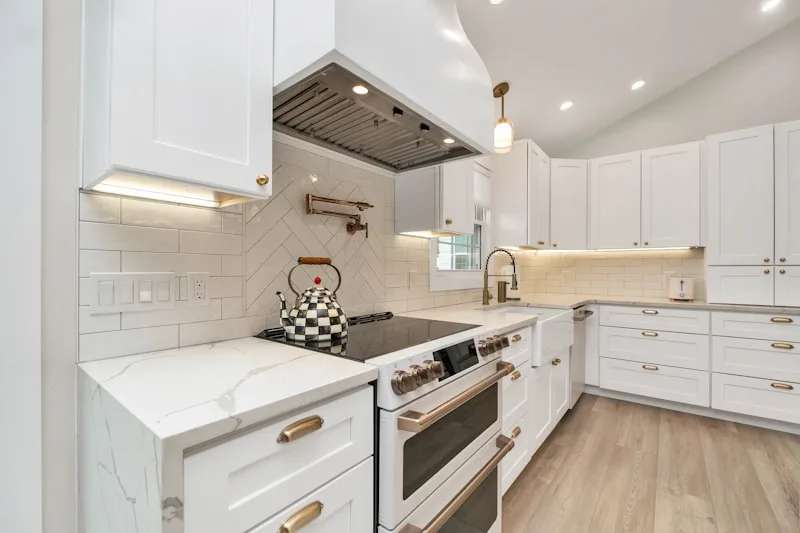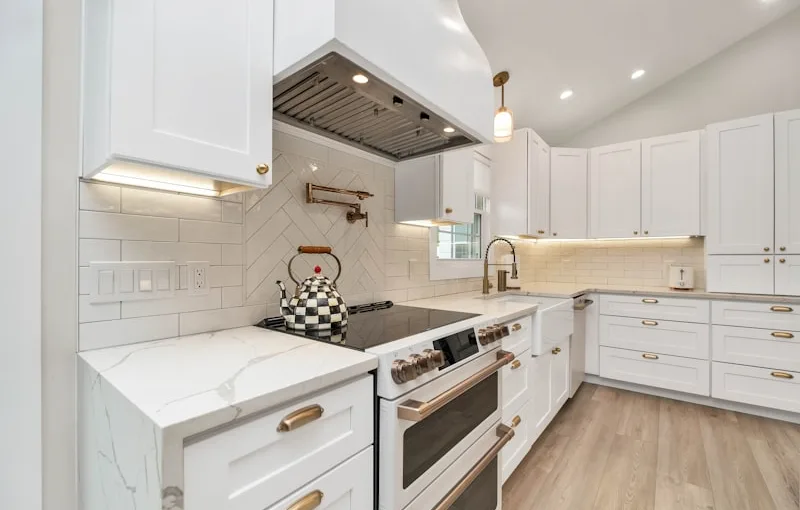First things first, grab a tape measure and a notepad. Start by measuring the width of each wall where you plan to install cabinets. Don’t forget to jot down any windows, doors, or outlets that might get in the way. Think of these as the obstacles in your kitchen obstacle course! You want to navigate around them smoothly.
Next, measure the height from the floor to the ceiling. This is crucial because you want to maximize your storage without hitting your head every time you reach for that top shelf. If you have any crown molding or other architectural features, make sure to account for those too. It’s like making sure your cake has the right frosting—presentation matters!
Now, let’s talk depth. Standard cabinets are usually 24 inches deep, but if you’re going for something custom, measure how deep you want them to be. Picture this: you don’t want your cabinets sticking out like a sore thumb, right? They should blend seamlessly with your kitchen layout.
The Ultimate Guide: Measuring Your Kitchen for Perfect Cabinet Fit
Start by measuring the width, height, and depth of your existing cabinets or the space where you plan to install new ones. Picture this: you wouldn’t buy a pair of shoes without trying them on, right? The same goes for cabinets! You want to ensure they fit snugly without any awkward gaps.
Next, measure the walls. Don’t just go for the obvious spots; check for any bumps, outlets, or pipes that might throw a wrench in your plans. Think of your kitchen as a canvas, and you’re the artist. Every little detail matters!
Now, let’s talk about the layout. Are you going for a U-shape, L-shape, or maybe a galley style? Visualize how you want your kitchen to flow. You wouldn’t want to trip over your own feet while cooking, would you?
Once you’ve got all your measurements, sketch it out. It doesn’t have to be a masterpiece—just a simple drawing will do. This will help you see how everything fits together. And remember, it’s always better to measure twice and cut once.
Avoid Costly Mistakes: Essential Tips for Measuring Kitchen Cabinets
First off, grab a trusty tape measure. It’s your best friend in this adventure. Start by measuring the height, width, and depth of the space where your cabinets will go. But here’s the kicker: always measure in multiple spots. Walls can be wonky, and you don’t want to assume that everything is perfectly straight. Think of it like checking the weather before a picnic; you wouldn’t want to be caught in the rain because you didn’t look!
Next, consider the layout. Are you going for a U-shape, L-shape, or maybe a galley kitchen? Visualize how the cabinets will flow with your kitchen’s design. It’s like planning a dance; you want everything to move smoothly together. And don’t forget about the appliances! Make sure to measure around your fridge, stove, and dishwasher. You wouldn’t want your cabinets to block your oven door, right?
Also, keep in mind the height of your countertops. Standard countertops are about 36 inches high, but if you’re on the taller side, you might want to adjust that. It’s all about comfort and functionality. Imagine trying to cook while hunched over; not fun!
From Chaos to Clarity: A Step-by-Step Approach to Kitchen Cabinet Measurements
First things first, grab a trusty tape measure. This little tool is your best friend in the world of home improvement. Start by measuring the width of your cabinets. It’s like measuring the width of a doorway before you try to move a couch through it—super important! Make sure to measure at the top, middle, and bottom, just in case your walls aren’t perfectly straight.
Next up, let’s talk height. Measure from the floor to the top of the cabinet. If you’re planning to install crown molding, don’t forget to account for that extra height. Think of it as adding a cherry on top of your kitchen sundae!
Now, depth is where things can get a bit tricky. Measure from the back of the cabinet to the front. This is crucial for ensuring your new appliances fit snugly without sticking out like a sore thumb.
And here’s a pro tip: jot down your measurements as you go. It’s like keeping score in a game—trust me, you don’t want to forget where you stand!
Lastly, don’t forget to measure the space between cabinets and any obstacles like windows or appliances. This is your kitchen’s way of saying, “Hey, don’t forget about me!”
By following these simple steps, you’ll turn that overwhelming task into a straightforward process. So, roll up your sleeves, grab that tape measure, and let’s get to work!
Maximize Your Space: How to Accurately Measure Your Kitchen for Cabinets
First off, grab a trusty tape measure. You’ll want to measure the width, height, and depth of your kitchen walls. Start from one corner and work your way around. Don’t just measure once; go over it a couple of times to ensure accuracy. It’s like double-checking your math homework—better safe than sorry!
Next, consider the layout. Are you working with a galley kitchen, an L-shape, or something more unique? Each layout has its quirks, and understanding them will help you visualize where those cabinets will go. Picture your kitchen as a puzzle; every piece needs to fit perfectly for the whole picture to come together.
Now, let’s talk about obstacles. You know, things like windows, doors, and electrical outlets. Measure their locations too! It’s like navigating a minefield—one wrong step, and you could end up with cabinets blocking your favorite window view or, worse, covering an outlet you need.
Finally, don’t forget about the height! Standard cabinet heights are usually around 30 inches, but if you’re tall or short, you might want to adjust that. Think of it as customizing a pair of shoes; you want them to fit just right.
Cabinet Confusion? Simplifying the Measurement Process for Your Kitchen

First things first, grab a tape measure. This trusty tool is your best friend in the world of cabinet measurements. Start by measuring the width of your walls where the cabinets will go. It’s like measuring the length of a fishing line before you cast your reel—get it right, and you’re set for success! Don’t forget to jot down your measurements; trust me, you’ll thank yourself later.
Next, let’s talk height. Measure from the floor to the ceiling, but keep in mind any crown molding or light fixtures that might get in the way. Think of it as checking the height of a roller coaster before you hop on—safety first! If you’re planning to install upper cabinets, consider how high you want them to sit. A good rule of thumb is to leave about 18 inches between the countertop and the bottom of the upper cabinets. This space is like the breathing room in a good song—it just makes everything flow better.
Now, let’s not forget about depth. Standard cabinets are usually 24 inches deep, but if you’re working with a smaller kitchen, you might want to consider shallower options. It’s like choosing between a deep dish pizza and a thin crust—both are delicious, but one might just fit your appetite better!
By breaking down the measurement process into these simple steps, you’ll be well on your way to transforming your kitchen without the headache. So, roll up your sleeves, grab that tape measure, and let’s get to work!
DIY Kitchen Makeover: Mastering the Art of Cabinet Measurement
First things first, grab a trusty tape measure. This little tool is your best friend in the world of DIY. Start by measuring the height, width, and depth of your existing cabinets. Don’t just eyeball it; precision is key! You wouldn’t want to buy a beautiful cabinet only to find it doesn’t fit your space. Think of it like shopping for clothes—if you don’t know your size, you might end up with something that’s too tight or way too loose.
Next, consider the space around your cabinets. Are there any appliances or fixtures that could throw a wrench in your plans? Measure the distance between your cabinets and the countertops, and don’t forget about the ceiling height. It’s like playing Tetris; you want everything to fit perfectly without any awkward gaps.
And here’s a pro tip: always measure twice, cut once. It’s a mantra for a reason! If you’re planning to add new cabinets or rearrange the old ones, sketch it out. Visualizing your kitchen can help you see how everything will come together.
Lastly, don’t forget about the style you want to achieve. Whether it’s modern chic or rustic charm, your measurements will guide you in selecting the right cabinets that complement your vision. So, roll up your sleeves, get those measurements down, and let your kitchen transformation begin!
Frequently Asked Questions
How Do I Measure for Cabinet Height and Depth?
To measure cabinet height, use a tape measure from the floor to the desired top of the cabinet. For depth, measure from the front edge to the back wall. Ensure to account for any trim or molding that may affect the measurements.
What Tools Do I Need to Measure Kitchen Cabinets?
To accurately measure kitchen cabinets, you will need a tape measure, a level, a pencil, and a notepad. The tape measure helps you obtain precise dimensions, while the level ensures that surfaces are even. Use the pencil to mark measurements, and the notepad to record your findings for reference during installation or shopping.
What Measurements Are Essential for Kitchen Cabinets?
To ensure a proper fit for kitchen cabinets, essential measurements include the height, width, and depth of the space where the cabinets will be installed. Additionally, measure the distance from the floor to the ceiling, the location of plumbing and electrical outlets, and the dimensions of appliances. Accurate measurements help in selecting cabinets that fit seamlessly and function effectively in your kitchen.
Tips for Accurate Kitchen Cabinet Measurements.
To ensure precise kitchen cabinet measurements, start by using a reliable tape measure. Measure the width, height, and depth of the space where the cabinets will be installed. Always measure in multiple places to account for any irregularities in the walls or floors. Record measurements in inches and note any obstacles like windows or outlets. Double-check your figures before making any purchases to avoid costly mistakes.
How Do I Measure My Kitchen for Cabinets?
To measure your kitchen for cabinets, start by clearing the area and using a tape measure. Measure the width and height of each wall where cabinets will be installed. Note the location of windows, doors, and any obstructions. For base cabinets, measure from the floor to the desired height, typically 34.5 inches. For wall cabinets, measure from the floor to the bottom of the cabinet, usually 18 inches above the countertop. Record all measurements accurately to ensure a proper fit.
